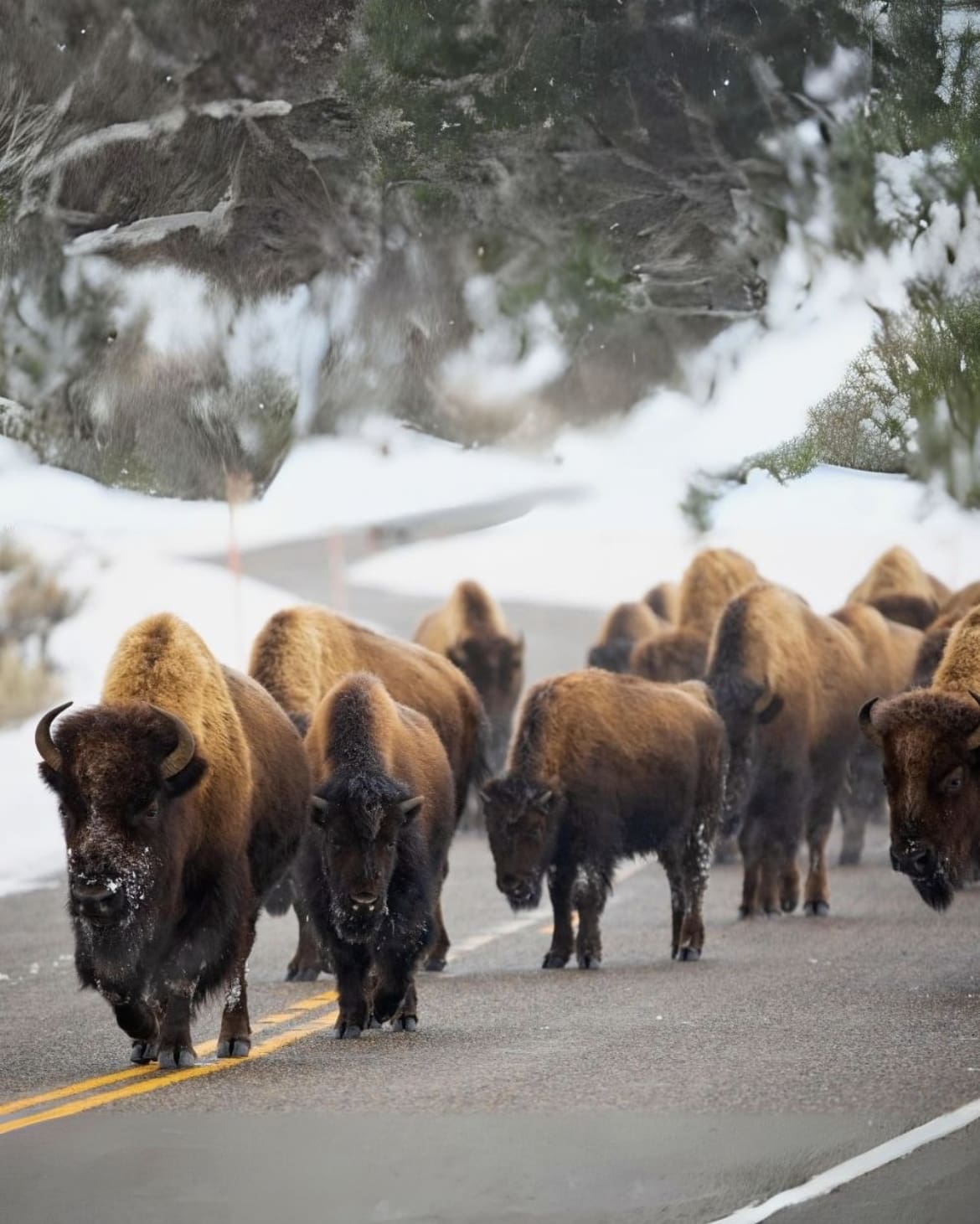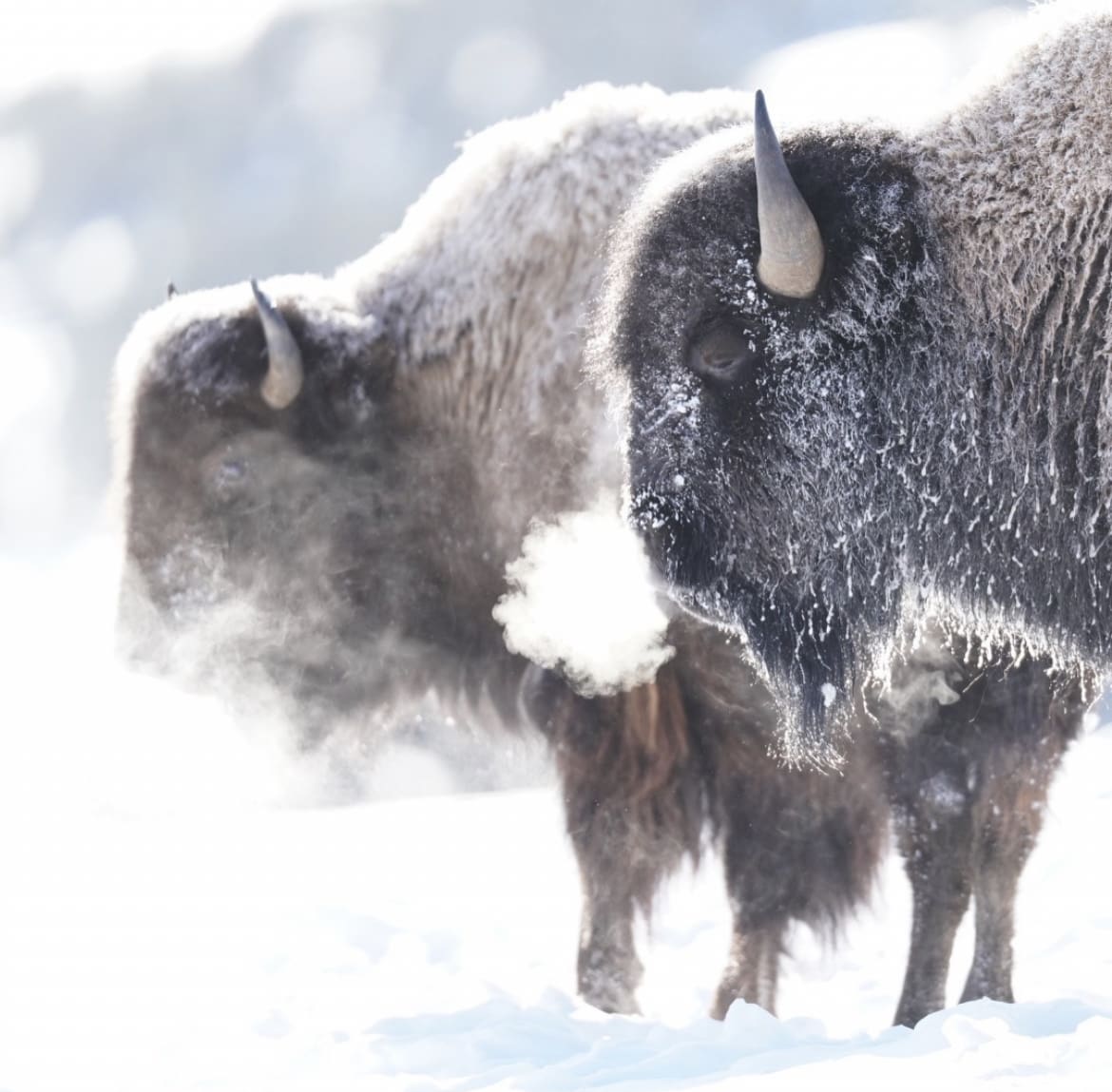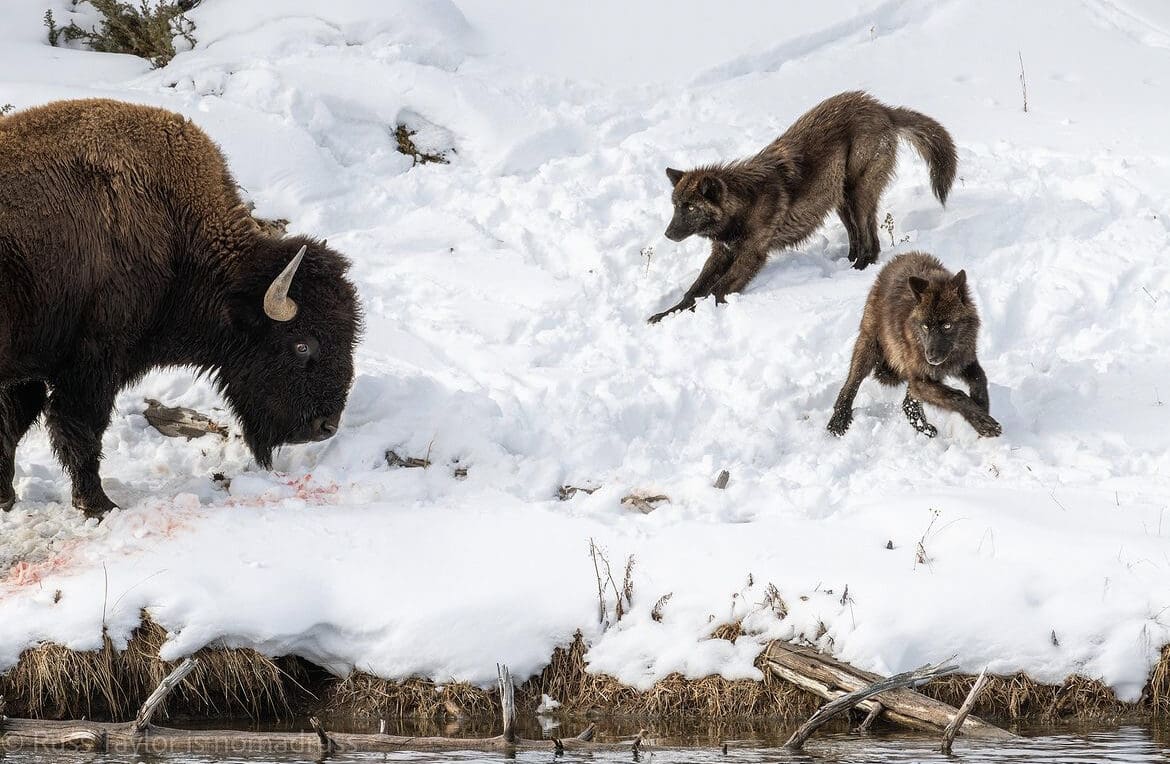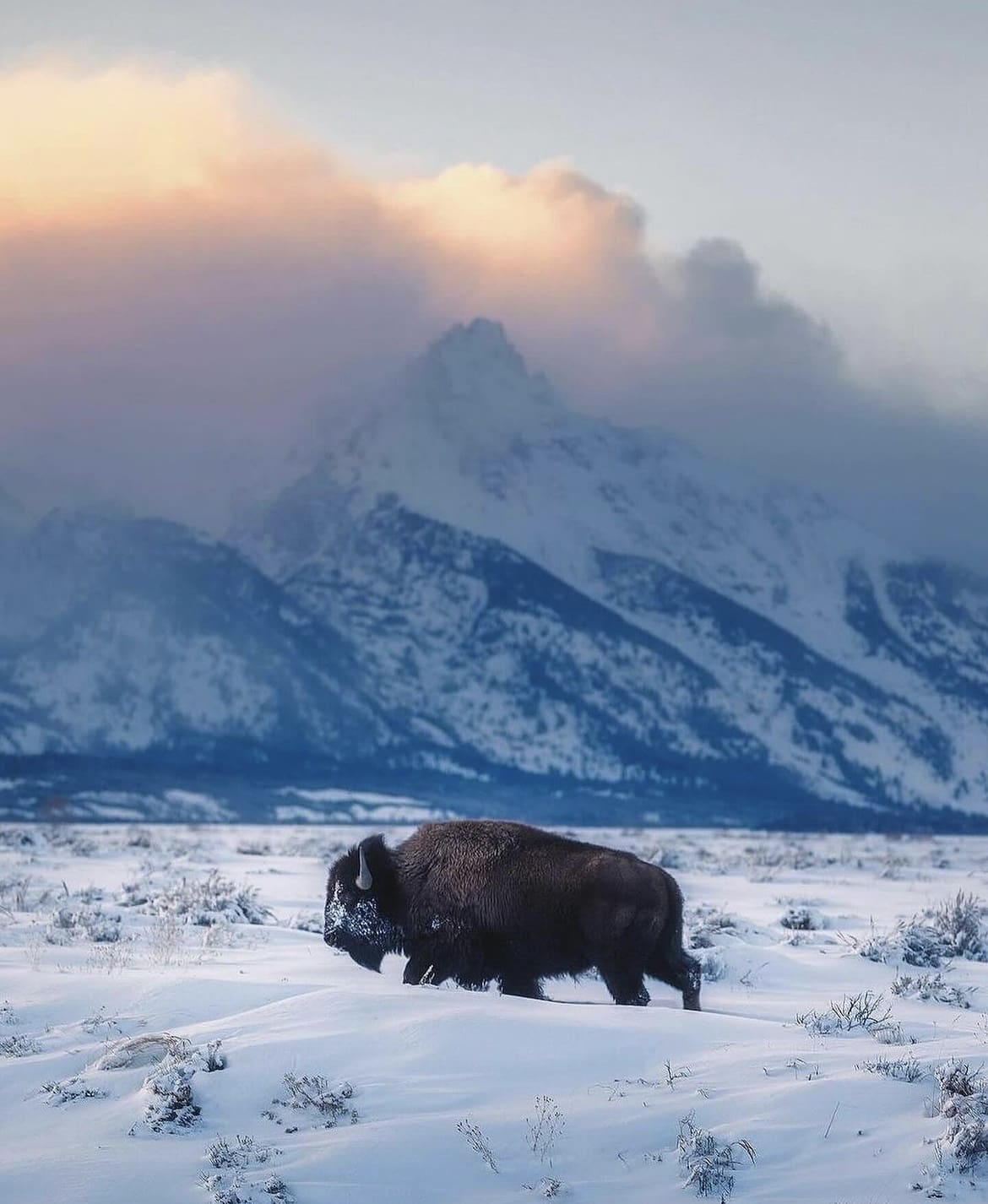One of the most badass creatures roaming the American plains is the bison. These beasts aren’t just big; they’re a symbol of the wild, untamed landscapes that still capture our imagination.
What is the Bison
When you hear “bison,” you might think of a large, furry animal chilling in Yellowstone, and you wouldn’t be wrong. But there’s so much more to these creatures than their chill vibe. Bison are the heavyweight champs of North America, playing a crucial role in the grassland ecosystem and holding a sacred spot in the cultural heritage of numerous Native American tribes.
Believe it or not, these behemoths are more than just muscle. They’re key players in their ecosystems, helping to keep the balance by munching on grass and thus, managing the prairie to support a diversity of life. Plus, their history is as deep and complex as the landscapes they roam. From near extinction in the 19th century due to overhunting and habitat loss, to becoming a conservation success story, bison are true survivors.
Bison vs Buffalo
Let’s clear up a common mix-up right off the bat: bison and buffalo are not the same. While you might hear people use the terms interchangeably, especially in the U.S., there’s a world of difference between them. Bison are the shaggy beasts of North America and Europe, sporting heavy coats and rocking those iconic humped shoulders along with a pair of wickedly sharp horns.
On the flip side, buffalo refer to two different species found in Africa and Asia. Think of the African buffalo (Cape buffalo) and the Asian water buffalo. These guys lack the hump and the heavy coat but make up for it in attitude. So next time someone talks about buffalo roaming the U.S. plains, you can drop some knowledge on them: it’s bison territory, baby.

What do Bison Look Like
Imagine a linebacker mixed with a shaggy rock star, and you’re halfway to picturing a bison. These creatures are built like tanks, with a massive head, broad shoulders, and a thick coat that makes them look even bulkier. They’ve got a distinctive hump on their back, which is actually a muscle they use to power through snow in search of food. Hardcore, right?
Bison faces have a kind of rugged charm, with a beard that any hipster would envy and a pair of deeply set, dark eyes that seem to hold centuries of prairie wisdom. Their fur, a mix of brown, black, and sometimes even a rusty hue, adds to their mystique, flowing elegantly as they move with surprising grace across the plains.
How Big are Bison
When we say bison are big, we’re not messing around. Picture this: a male (bull) can tip the scales at over 2,000 pounds—that’s like stuffing 10 adult men into a furry suit and letting it roam the grasslands.
Females (cows) are no dainty flowers either; they can weigh up to 1,000 pounds. And in terms of height, we’re talking about animals that stand 6 to 6.5 feet tall at the shoulder. That’s taller than most NBA players if they were to go head-to-head. These creatures aren’t just big; they’re nature’s tanks, roaming the plains with an authority that says, “Move over, I’m grazing here.”
Bison Skin
Now, let’s talk about that rugged bison coat. If you think it’s all for show, think again. Their skin is a masterpiece of natural design, perfect for the harsh climates they endure.
The outer layer of fur, which gets all shaggy and magnificent, is designed to shed water and snow, while the undercoat is thick and woolly, trapping heat like a natural thermal blanket. This dual-layer coat means bison can chill (figuratively speaking) in the middle of a snowstorm like it’s a sunny day at the beach.
When spring rolls around, they shed this heavy coat in clumps that birds love to snag for nesting material. Talk about being an eco-friendly fashion icon!

Bison Tails
And what about those tails? Bison tails are like their own personal signal flags. Typically around 18 to 24 inches long, these tails aren’t just for swatting flies—though they do a stellar job at pest control.
When a bison is relaxed, its tail hangs down, casually flipping at insects. But when a tail stands straight up, it’s time to pay attention because it means the bison is either startled or ready to charge. It’s like their version of a mood ring, except you really don’t want to be around when it signals “angry.”
Bison Horns
Bison horns are like the Swiss Army knives of the animal kingdom—used for defense, dominance, and digging through snow to find food in the winter. These aren’t your average antlers that get shed every year; bison horns are here to stay, growing throughout their lives.
A typical horn can curve upwards and outwards, reaching lengths of up to two feet. Just imagine locking horns with someone and using that as a way to say, “Back off, buddy, this grass patch is mine!” That’s exactly what bison do during mating season, using their horns in fierce battles to impress the ladies and claim their spot at the top of the bison social ladder.
Bison Coloration
Bison coloration is the kind of topic that makes you appreciate nature’s palette. These beasts aren’t just sporting one shade of brown; they’ve got a range that includes deep chocolate, rusty amber, and even some cooler, almost grayish tones.
Calves throw a curveball in the color game, starting life with a reddish-brown coat that makes them stand out from the darker adults.
This colorful coat doesn’t just make them look good; it helps with camouflage among the grasses and brush, blending in to avoid predators.

What do Bison Eat?
Bison are the OG vegans of the plains, with a diet that’s strictly plant-based. They’re not picky eaters; if it’s green and grows on the ground, it’s on the menu. This means a lot of grasses, herbs, and even some shrubs. With their strong, muscular tongues, they can easily wrap around their chosen vegetation, pulling it into their mouths for a good chew.
What’s fascinating is how their eating habits impact the environment. Bison grazing is a form of natural landscaping, promoting the growth of a variety of plant species and maintaining healthy prairies. They’re like the gardeners of the Great Plains, ensuring that the ecosystem stays balanced and diverse. Plus, their movements and grazing patterns help to spread seeds, contributing to the regeneration of the grasslands.
Bison Social Structure
When it comes to hanging out, bison are all about community vibes. They’re not the solitary types; instead, they form groups known as herds, which can range from the cozy family units to the massive congregations that turn the prairie into a bison block party. These herds are structured around the females and their young, while the males may form their own groups or wander solo until it’s time to impress the ladies during the mating season, known as the rut.
What’s fascinating is how these social structures play a crucial role in their survival. In a herd, bison can better defend against predators, find food, and take care of their young. It’s like their own version of a neighborhood watch, but with more fur and grunting. Communication within the herd is key, using a series of grunts, snorts, and body movements to say everything from “Hey, follow me to the waterhole” to “Back off, you’re crowding my space.”
How do Bison Reproduce?
When mating season rolls around, things get interesting. The rut, taking place in the late summer, turns the prairie into a bison version of a dating game, with males showcasing their strength and stamina through head-butting contests and other displays of dominance. It’s not just about brute force, though; males must also woo the females with their charm (or, you know, their bison equivalent).
After a successful courtship, the gestation period for a bison lasts about 9 months, leading to the birth of a single calf in the spring. These calves hit the ground running, quite literally, as they’re able to stand and walk within hours of being born. This quick start is crucial for their survival in the wild, ensuring they can keep up with the herd and avoid predators.
@drew.simms
How Long do Bison Live?
Life in the wild can be tough, but bison are built to endure. On average, these sturdy creatures can live up to 20 years in the wild, with some individuals reaching the ripe old age of 25. In the more controlled environment of a reserve or park, they might even surpass that, thanks to the absence of predators and regular health checks.
Their longevity is a testament to their resilience and the effectiveness of their social structures. From the protective herd dynamics to their robust physical attributes, every aspect of bison life is geared towards survival. It’s this combination of social bonds, reproductive strategies, and natural toughness that has allowed the bison to thrive for centuries, facing down challenges and emerging as symbols of the untamed spirit of the American wilderness.
Are Bison Aggressive?
When you picture a bison, you might imagine a serene giant, calmly grazing on the plains. And while they do prefer peace and quiet, let’s not forget that these are wild animals, each weighing up to a ton and equipped with horns. So, are they aggressive? Well, it’s complicated. Bison generally keep to themselves, but they have a strong sense of personal space. Wander too close, and their demeanor can quickly shift from placid to “I’m going to charge at you now.” It’s their way of saying, “Respect my boundaries, or there’ll be consequences.”
Bison aggression is mostly seen during the rutting season when males compete for females’ attention. This is when the head-butting, snorting, and charging really kick into high gear. But even outside of mating season, they can be protective of their young or if they feel threatened. The key takeaway? Always admire these majestic creatures from a safe distance.
Are Bison Territorial?
Bison roam, and they roam far and wide. Unlike some animals that stake a claim to a specific piece of land and defend it fiercely, bison are more about the “nomadic life.” Their territory is wherever the grass is green, and the water is accessible. This doesn’t mean they’re without any sense of territoriality, though. During the rut, males can become more possessive over space and females, but this is more about proving their worth than defending a permanent home base.
Their migratory nature plays a crucial role in the health of the ecosystems they inhabit. By moving across vast areas, they help to distribute seeds, create habitats for other species by wallowing, and maintain the grasslands through their grazing habits. So, while they’re not territorial in the classic sense, they’re pivotal in shaping and sustaining their environment.

Where do Bison Live?
Once, bison roamed across much of North America, from the forests of Alaska to the grasslands of Mexico. Today, their range has significantly shrunk, but you can still find them in pockets of the United States, Canada, and even parts of Mexico. The largest populations reside in national parks and reserves, such as Yellowstone National Park, where they’ve become symbols of the American West.
Bison are adaptable and can thrive in various habitats, from grasslands to forests, as long as there’s enough food and water. Their ideal environment is the open prairie, where they have ample space to graze, move, and live out their natural behaviors. Conservation efforts in recent decades have focused on restoring bison to their natural habitats, aiming to reestablish the balance of these ecosystems and ensure the survival of this iconic species.
How Many Bison Are There in the Wild?
Rewind a couple of centuries, and bison were as synonymous with the American West as the setting sun. Estimates suggest there were once as many as 30 to 60 million bison roaming North America. But by the late 19th century, unregulated hunting and habitat loss had nearly wiped them out, with the population plummeting to a few hundred. It’s one of the most devastating examples of how humans can impact wildlife.
Fast forward to today, and the picture is a bit more hopeful, thanks to concerted conservation efforts. There are now approximately 500,000 bison in the United States, but it’s important to note that the majority of these are managed for commercial purposes, and only about 30,000 are considered wild and managed for conservation in public and private herds. While these numbers are a fraction of their historic populations, they mark a significant comeback for a species once on the edge of extinction.
Are Bison Endangered?
The question of whether bison are endangered is a bit nuanced. The species as a whole, thanks to those conservation efforts and breeding programs, is no longer on the brink. However, certain subspecies, like the wood bison found in Canada, are considered threatened or endangered in specific regions. The distinction here is crucial because it highlights the ongoing need for targeted conservation strategies to protect these vulnerable populations from slipping back towards the edge.
The story of the bison’s recovery is a conservation success story, showcasing what can be achieved with dedication and cooperation. However, it’s also a reminder that success is fragile, and continuous effort is required to maintain and build upon these gains.

Threats to Bison in the Wild
Despite the progress, the road ahead isn’t without its potholes. Bison continue to face several threats that could jeopardize their hard-won gains. Habitat loss remains a significant concern as urban expansion, agriculture, and development encroach on the grasslands essential for their survival. This not only reduces their living space but can also lead to conflicts with humans as bison wander into agricultural areas in search of food.
Disease is another looming threat, with issues like brucellosis affecting both wild bison and livestock. This disease can lead to cattle abortions, prompting ranchers to support measures that keep bison away from their herds, sometimes at the expense of the bison’s freedom to roam.
Moreover, climate change poses a long-term threat by altering the ecosystems bison depend on for food and water. Changes in precipitation patterns, temperature shifts, and increased frequency of extreme weather events can disrupt the delicate balance of the grasslands, affecting the quality and availability of the bison’s food sources.
Where to See Bison
Yearning for a bison encounter? You’re in luck. The United States boasts several prime locations where bison roam free, and witnessing them in their natural habitat is nothing short of spectacular.
Yellowstone National Park is perhaps the most famous, offering a backdrop of stunning landscapes where bison have roamed for centuries. Custer State Park in South Dakota and the National Bison Range in Montana also provide breathtaking opportunities to observe these beasts in the wild.
For those venturing into Canada, Wood Buffalo National Park is home to the largest herd of wood bison, a subspecies of the American bison.
Tips for Spotting Bison
If you’re gearing up for a bison safari, remember these golden rules: patience is your best friend, and safety is paramount. These creatures may seem docile at times, but they’re unpredictable and incredibly fast for their size.
Always keep a safe distance — at least 25 yards is recommended. Early morning or late afternoon are prime viewing times, as bison are most active during the cooler parts of the day. Don’t forget your binoculars and camera, but also take a moment to put the gadgets down and soak in the majesty of these animals with your own eyes.

Facts about The Bison
- Majestic Migrators: Bison can travel up to 2,000 miles a year, showcasing their incredible endurance and the importance of large, connected habitats.
- Speedy Giants: Despite their bulky size, bison can run up to 35 miles per hour. That’s faster than Usain Bolt!
- Survival of the Fittest: A bison’s hump is not just for show. It’s packed with muscles that help them plow through snow in search of food during the harsh winter months.
- Ecosystem Engineers: Bison play a crucial role in their ecosystems by grazing selectively, which helps maintain the health and diversity of the grasslands.
Myths about The Bison
- Bison vs. Buffalo Confusion: Many think “bison” and “buffalo” are interchangeable. However, true buffalo species reside in Africa and Asia. The term “buffalo” was a misnomer given by early European settlers.
- The Inextinguishable Population Myth: There’s a myth that bison populations were once so vast, they could never be depleted. This underestimation led to their near extinction in the 19th century.
- Bison Are Domesticated: While some bison are raised on ranches, they are not domesticated animals. Bison have retained much of their wild instincts, unlike their cattle cousins.
Whether you’re gazing at a solitary bison against the backdrop of Yellowstone’s geysers, learning about their critical role in the ecosystem, or debunking the myths that have long surrounded these creatures, the story of the bison is a compelling narrative of resilience, beauty, and the interconnectedness of nature.
Through the highs and lows, from the brink of extinction to their triumphant return, bison continue to captivate and inspire, reminding us of the importance of coexistence, conservation, and the unwavering spirit of the wild that persists in the face of adversity. So, the next time you find yourself in the presence of these magnificent animals, take a moment to appreciate not just the bison before you, but the vast, unfolding story they represent.
